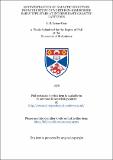Files in this item
An investigation of galactic structure made from the study of the northern-hemisphere early type stars at intermediate galactic latitudes
Item metadata
| dc.contributor.advisor | Hill, Philip W. | |
| dc.contributor.author | Lynas-Gray, A. E. | |
| dc.coverage.spatial | 342 p. | en_US |
| dc.date.accessioned | 2018-06-20T11:18:43Z | |
| dc.date.available | 2018-06-20T11:18:43Z | |
| dc.date.issued | 1976 | |
| dc.identifier.uri | https://hdl.handle.net/10023/14329 | |
| dc.description.abstract | Photometric and spectroscopic observations have been made of northern hemisphere early type stars at intermediate galactic latitudes. Stellar distances, the corresponding distances from the galactic plane and the interstellar reddening along the lines of sight have been derived. The available published data was used to support the observational results. The HI spiral features seem to have corresponding optical counterparts, and the agreement between the two patterns is remarkably good. The neutral hydrogen kinematic distances depart from the stellar distances. This can be explained in terms of the density wave theory, with a small modification which may be the result of a non-zero distance from the galactic plane. The Local Arm extends to about 500pc above the galactic plane and the Perseus Arm to 1 kpc. Thus it seems that the interpretation of intermediate latitude high and intermediate velocity features, as vertical extensions to the spiral arms in the galactic plane, may be correct. Stellar and interstellar calcium radial velocities suggest that these intermediate latitude spiral features adhere closely to differential galactic rotation, and that the small departures from this motion exhibit a significant correlation with the predictions of the density wave theory. Published proper motions are used together with the stellar radial velocities to derive the components of the stellar space motions with respect to their local standards of rest. In cases where the component normal to the galactic plane was significantly different from zero, the dynamical lifetime was calculated on the assumption that the star was formed in the galactic plane. These were found to be compatible with the evolutionary lifetimes for only half of the stars considered, suggesting that about 50% of intermediate latitude OB stars were formed in or near the galactic plane and subsequently ejected from it. The remainder seem to have been formed at considerable distances from the galactic plane, and a scheme for explaining this is proposed. This scheme also explains the apparent asymmetry between the northern and southern galactic hemispheres. A few interesting high velocity stars and OB star associations are also considered. | en_US |
| dc.language.iso | en | en_US |
| dc.publisher | University of St Andrews | |
| dc.subject.lcc | QB807.L9G8 | |
| dc.subject.lcsh | Astrometry | en |
| dc.title | An investigation of galactic structure made from the study of the northern-hemisphere early type stars at intermediate galactic latitudes | en_US |
| dc.type | Thesis | en_US |
| dc.contributor.sponsor | University of St Andrews | en_US |
| dc.contributor.sponsor | Dublin Institute for Advanced Studies | en_US |
| dc.contributor.sponsor | Science Research Council (Great Britain) | en_US |
| dc.contributor.sponsor | France (Government) | en_US |
| dc.type.qualificationlevel | Doctoral | en_US |
| dc.type.qualificationname | PhD Doctor of Philosophy | en_US |
| dc.publisher.institution | The University of St Andrews | en_US |
| dc.publisher.department | Commission des Programmes; Large Telescope Users Panel | en_US |
This item appears in the following Collection(s)
Items in the St Andrews Research Repository are protected by copyright, with all rights reserved, unless otherwise indicated.

